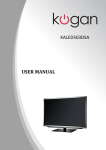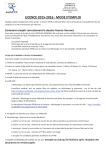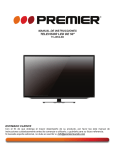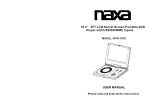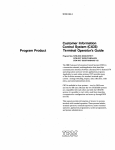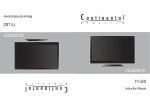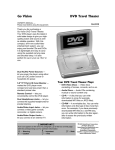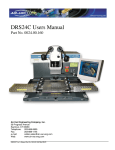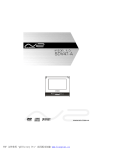Download KGN&, > ϯϮs USER MANUAL
Transcript
KGN&,>ϯϮs USER MANUAL Important Safety Instructions and Maintenance Important Safety Instructions CAUTION Risk of electronic shock, do not open. Do not attempt to service this product yourself as opening or removing covers may expose you to dangerous voltage or other hazards. Refer all servicing to qualified service personnel. High Voltage Do not open If the following problems occur: Turn off the TV set and unplug the AC power cord immediately if any of the following problems occur. Ask your dealer or service centre to have it checked by qualified service personnel When: - AC power cord is damaged. - Poor fitting of AC power outlet. - TV set is damaged by being dropped, hit or having something thrown at it. - Any liquid or solid object falls through openings in the cabinet. To reduce the risk of fire or electric shock, do not expose this product to rain or moisture. The apparatus shall not be exposed to dripping or splashing and no objects filled with liquids, such as vases, shall be placed on the apparatus. The screen and cabinet get warm when the TV is in use. This is not a malfunction.In case of smoke, strange noise or strange smell from the unit: · Turn off the power switch immediately; · Disconnect the power plug from the power outlet; · Contact your dealer or service centre. Never attempt to make repairs yourself because this could be dangerous. Never push objects of any kind into the set through the cabinet slots as they may touch dangerous voltage points or short-circuit parts that could result in a fire or electric shock. Never spill liquid of any kind on the set. Use special caution in households where children are present. The apparatus is not suitable for children under 3-year to operate. Do not overload wall outlets, extension cords or adaptors beyond their capacity, this can result in fire or electrical shock. Power-supply cords should be routed so that they are not likely to be walked on or pinched by items placed upon or against them, paying particular attention to cords at plug end, adaptors and the point where they exit from the appliance. The mains plug is used as the disconnect device. It shall remain readily accessible and should not be obstructed during intended use. Make sure to plug the power cord in until it is firmly inserted. When removing the power cord, make sure to hold the power plug when pulling the plug from the outlet, do not pull the plug out by the wire. NEVER touch the plug or power cord with wet hands. To disconnect the apparatus from the mains power, the plug must be pulled out from the mains socket, therefore make sure the mains plug is always easily accessible. 1 Important Safety Instructions and Maintenance Important Safety Instructions Do not push or scratch the front filter, or place any objects on top of the TV set. The image may be uneven or the screen may be damaged. To avoid the fire, no naked flame source, such as lighted candles, should be placed on the apparatus. An outside antenna system should not be located in the vicinity of overhead power lines or other electric light or power circuits, or where it can fall into such power lines or circuits. When installing an outside antenna system, extreme care should be taken to keep from touching such power lines or circuits as contact with them might be fatal.Ensuring the television is not overhanging the edge of the supporting furniture. When not in use If you will not be using the TV set for several days, the TV set should be disconnected from the AC mains for environmental and safety reasons. As the TV set is not disconnected from the AC power when the TV is turned off at the standby switch, pull the plug from the AC power outlet to disconnect the TV completely. However, some TV sets may have features that require the TV set to be left in standby to function correctly. In the case of lightning, unplug the TV set from the outlet immediately. Never touch the antenna wire during lightning. Do not pull the plug out by the wire; Never touch the plug with wet hands. Excessive volume from earphones and headphones can cause hearing loss. Installation The ventilation should not be impeded by covering the ventilation opening with items, such as newspapers, tablecloths, curtains, etc. At least 10 cm space should be left around the apparatus for sufficient ventilation. The product should be situated away from heat sources such as radiators, heat registers, stoves, or other products (including amplifiers) that produce heat. Place the apparatus in such a position that the screen is not exposed to direct sunlight. It is best to have soft indirect lighting while watching and avoid completely dark environments and reflection from the screen as these may cause eye fatigue. Keep the TV set away from any equipment emitting electromagnetic radiation. 2 Important Safety Instructions and Maintenance Installation Do not place the set on an unstable cart, stand, table or shelf. The set may fall, causing serious personal injury as well as damage to the product. Use only with the cart, stand, tripod, bracket, or table specified by the manufacturer, or sold with the apparatus. An appliance and cart combination should be moved with care. Quick stops, excessive force, and uneven surfaces may cause the appliance and cart combination to overturn. Do not place this apparatus near water, for example, near a bath tub, wash bowl, kitchen sink, or laundry tub; in a wet basement; or a swimming pool; and the like; Move When the TV being moved in from cold place, it needs some right time for dew inside unit evaporating fully before turn on the unit; To prevent injury, this apparatus must be securely attached to the floor/wall in accordance with the installation instructions. LCD Screen Although the LED screen is made with high precision technology and 99.99% or more of the pixels are effective, black dots may appear or bright points of light (red, blue or green) may appear constantly on the LED screen. This is a structural property of the LED screen and is not a malfunction. If the surface of the LCD panel cracks, do not touch it until you have unplugged the AC power cord. Otherwise electric shock may result. Do not throw anything at the TV set. The LCD panel may break from the impact and cause serious injury. Precautions When Displaying a Still Image A still image may cause permanent damage to the TV screen. Do not display still images and partially still images on the LED panel for more than 2 hours as it can cause screen image retention. This image retention is also known as "screen burn". To avoid such image retention, reduce the degree of brightness and contrast of the screen when displaying a still image. Watching the LED TV in 4:3 format for a long period of time may leave traces of borders displayed on the left, right and centre of the screen caused by the difference of light emission on the screen. Playing a DVD or a game console may cause a similar effect to the screen. Damages caused by the above effect are not covered by the Warranty. Displaying still images from Video games and PC for longer than a certain period of time may produce partial after-images. To prevent this effect, reduce the 'brightness' and 'contrast' when displaying still images. Cleaning Cleaning and handling the screen MAINS PLUG surface and cabinet. Disconnect Wipe the mains plug with the unit from the AC outlet before a dry cloth at regular cleaning. To remove dust, wipe intervals. Moisture and gently with a soft, lint free cloth. If dust may lead to fire or required use a slightly damp cloth. electrical shock. Use care not to subject the TV's surfaces to detergent. (A liquid inside the TV could lead to product failure, fire or electrical shock.) Use care not to subject surfaces to bug repellent, solvent, solvent thinner thinner, or other volatile substances as this may deteriorate the surface and finish of the cabinet. 3 Important Information Keep small accessories out of reach of children so they are not mistakenly swallowed. Table of Contents Accessories Introduction Accessories-----------------------------------------------------------------------------------------------5 Features---------------------------------------------------------------------------------------------------6 Specifications--------------------------------------------------------------------------------------------7 Stand and wall-mounted instructions (option)---------------------------------------------------8 Overview of back panel-------------------------------------------------------------------------------10 Overview of front panel-------------------------------------------------------------------------------11 Overview of remote control--------------------------------------------------------------------------12 Teletext ---------------------------------------------------------------------------------------------------14 Installing Batteries in the Remote Control--------------------------------------------------------16 External Connection--------------------------------------------------------------------------------------16 Antenna connection------------------------------------------------------------------------------------16 Connecting VCR ---------------------------------------------------------------------------------------17 Connecting a Camcorder-----------------------------------------------------------------------------18 Connecting a DVD Player/Set-Top Box ----------------------------------------------------------19 Connecting a DVD Player/Set-Top Box with DVI ----------------------------------------------20 Connecting DVD Player/Set-Top Box with HDMI ----------------------------------------------21 Connecting Digital Audio System-------------------------------------------------------------------22 Connecting Amplifier/DVD Home Theater -------------------------------------------------------22 Connecting PC -----------------------------------------------------------------------------------------23 Supporting signals ----------------------------------------------------------------------------------------23 Basic operation Turn the TV on and off--------------------------------------------------------------------------------24 Menu operation ----------------------------------------------------------------------------------------25 Menu system introduction-----------------------------------------------------------------------------27 Picture----------------------------------------------------------------------------------------------------27 Sound-----------------------------------------------------------------------------------------------------29 Channel--------------------------------------------------------------------------------------------------31 Time-------------------------------------------------------------------------------------------------------33 Option-----------------------------------------------------------------------------------------------------34 Function--------------------------------------------------------------------------------------------------36 PVR-------------------------------------------------------------------------------------------------------37 Digital Media Player -------------------------------------------------------------------------------------40 Reference Troubleshooting -------------------------------------------------------------------------------------------44 Picture defects and the reason-----------------------------------------------------------------------46 4 Accessories Please make sure the following items are included with your LED/LCD TV. If any items are missing, contact your dealer. POWER INPUT 1 2 3 4 5 7 8 9 INFO 0 RECALL 6 FREEZ E SLE EP ME NU OK/ REC LIST DT V HD M I US B AS PE CT MUTE VOL PROG AUDIO LA NG RED GREEN YELLOW HOLD SIZ E SU BTITL E MIX REVEAL SO UN D PICTURE IND EX BLUE TEX T Owner’s CANCEL PgUp PgDn TIM E SU BC OD E Instructions Remote Control CAUTION: Batteryx2 Do not dispose of batteries in a fire. Do not short circuit, disassemble or overheat the batteries. Danger of explosion if battery is incorrectly replaced, please observe polarity. Replace only with the same or equivalent type. Stand(1 Piece) AV cable(2 Pieces) M8X10,4 Pieces-see rear panel of TV. Mounting screws M4X10 ( 5 Pieces ) Stand screws 5 Introduction Features l l l l l l l l l l l TV adopts 32”/42”/46”TFT LED/LCD display screen Zero X radiation complies to green environment protection requirement Connect to computer directly to realize TV/monitor combo. 16:9 wide screen Auto tuning and fine tuning HDMI input Component Compatible (480i; 480P; 576i; 576P; 720P; 1080i; 1080P) PC VGA Programmable sleep timer Wide range voltage input No-signal automatic power off Input terminals used for external equipment connection 1 x ANTENNA jack 4 x HDMI inputs 1 x computer VGA/PC input 2 x USB inputs 1 x COMPONENT input 1 x AV output 3 x AV inputs 1 x SPDIF output 1 x Headphone output 6 Introduction Specifications Model Display size 32” Diagonal (max.) 42” Diagonal ( max.) 46” Diagonal (max.) LED panel resolution 1920X1080 1920X1080 1920X1080 Speaker output power ≥5 W X2 ≥5 W X2 ≥5 W X2 Power supply ~110-240V, 50/60Hz ~110-240V, 50/60Hz ~110-240V, 50/60Hz TV receive system Digital: DVB-T Analog: PAL: BG, DK, I, SECAM: BG, D/K Digital: DVB-T Analog: PAL: BG, DK, I, SECAM: BG, D/K Digital:DVB-T Analog: PAL: BG, DK, I, SECAM: BG, D/K Frequency range Analog: Antenna: 46.25MHz-855.25MHz Digital:5-12, 27-69 Analog: Antenna: 46.25MHz-855.25MHz Digital:5-12, 27-69 Analog: Antenna: 46.25MHz-855.25MHz Digital:5-12, 27-69 Video in PAL / NTSC / SECAM PAL / NTSC / SECAM PAL / NTSC / SECAM Power consumption 95W 135W 160W Standby consumption <1W <1W <1W Antenna Input 75 ohms, unbalanced 75 ohms, unbalanced 75 ohms, unbalanced Controller power DC 3V (Two AAA size batteries) DC 3V (Two AAA size batteries) DC 3V (Two AAA size batteries) 782 X 240 X 560 m m 1019X255X709 m m 1112X275X756 m m 782X41X525mm 1019X43X669mm 1112X42X724mm 11Kg 17.6Kg 20.7Kg 8.1Kg 14.2Kg 16.6Kg Work Temperature o o o 0 C-40 C o 0 C-40 C Note: - Design and specifications are subject to change without notice. - Weight and Dimension shown are approximate. 7 o o 0 C-40 C Stand and wall-mounting instructions (optional) How to assemble the stand If you need to remove or assemble the stand please read the following instructions. -Before attaching/detaching the stand, make sure to turn off the TV. -Before performing work, spread cushioning over the base area to lay the LED TV on. This will prevent it from being damaged. Screws(5-M4X10) Assembling instruction: 1) Fix the stand and the unit together with 5 screws. 2) To remove the stand, reverse instructions as above. Securing the TV Stand Caution: Pulling, pushing, or climbing on the TV may cause the TV to fall. In particular, ensure your children do not hang over or destabilize the TV; doing so may cause the TV to tip over, causing serious injuries or death. Follow all safety precautions at the start of this manual. For added stability, install the anti-fall device for safety purposes, as follows. ALTERNATIVELY To secure the TV to the wall: 1- Put the screws into the clamps and firmly fasten them onto the wall. Confirm that the screws have been firmly installed onto the wall. - You may need additional material such as an anchor depending on the type of wall. - Since the necessary clamps, screws, and string are not supplied, please purchase them separately. 2 - Remove the screws from the centre back of the TV, put the screws into the clamps, and then fasten the screws onto the TV again. - Screws may not be supplied with the product. In this case, please purchase the screws of the following specifications. - Screw Specifications for a 46 ~ 55 Inch LED TV: M8 X L10 8 Stand and wall-mounting instructions (optional) 3 - Connect the clamps fixed onto the TV and the clamps fixed onto the wall with a strong cable. - Install the TV near to the wall so that it does not fall backwards. - It is safe to connect the string so that the clamps fixed on the wall are equal to or lower than the clamps fixed on the TV. - Remove the cable before moving the TV. 4 - Verify all connections are properly secured. Periodically check connections for any sign of fatigue for failure. If you have any doubt about the security of your connections, contact a professional installer. Wall Wall mounting instructions (optional) Your LCD TV is able to accommodate wall mounting with the use of a wall mount bracket (not supplied with LCD TV, please contact your local hardware store) and the mounting holes on the back of the unit. We recommend removing the TV stand prior to wall mounting the TV. Please see previous page for instructions on removing the stand. How to mount the LCD TV on the wall 1.After detaching the stand, fasten 4 mounting screws (thread size M8X10 - not supplied! Please contact your local hardware store) into the 4 screw holes on the rear cover, see the figure below. 2.Fasten wall mounting bracket (Not supplied with LCD TV, please contact your local hardware store) with screws on the wall. 3.Carefully check for the strength before releasing the LCD TV. NOTE: For more detailed instructions please refer to your “after market” wall mounting instruction book. KDL46JS97A Thread hole size – M8 x 10 depth (TV mounting screw size) on the TV. 9 General Description Overview of back panel You can connect the TV with video devices such as DVD/VCD player, VCR and video camera to enjoy the high quality picture. OUT AV IN HDMI 2 IN HDMI 1 AUD IO VGA OUT SPDIF ANT US B 2 USB2 US B 1 USB1 HD MI 4 HD MI 3 Camcorder Headphone PC DVD player Video game equipment PC (HDMI-output) Y/VIDEO Home theatre system with digital input DVD player Blu-ray disc player AV 1 I N VCR Audio system 10 DVD player with component output General Description Overview of front panel The buttons on the lower-right panel control your TV’s basic features, including the on-screen menu. To use the more advanced features, you must use the remote control. TV/AV Toggles between all the available input sources. MENU Press to see an on-screen menu of your TV's features. PROG r/s Press to change programs. In the on-screen menu, use the PROG r/sbuttons as up/down arrow buttons. VOL+/Press to increase or decrease the volume. In the on-screen menu, use the VOL+/-buttons as left/ right arrow buttons. Standby button Press button to toggle between normal and standby mode. POWER INDICATOR Red: In standby mode. REMOTE CONTROL SENSOR Aim the remote control towards this spot on the TV. POWER SWITCH Note: 1. Sensor lights will turn off within 6 seconds of the last operation. 2. In order to avoid errors, the TV will go into standby mode after touching the standby button for 2 seconds. In standby mode, the standby indicator will remain illuminated, all other indicators will be off. 3. When the sensor indicator lights are off, they are still active and will respond to the first touch. 4. Please do not touch the buttons in rapid suc cession. 5. When the TV initialises during power up, all sensor lights on the front panel will flash sequentially, cycling from left to right. When the TV has finished the initialising process, the cycle will cease and all light indicators will remain off until touched. 6. When recording in normal/standby mode, the logo will cycle from bright to dull for the duration of the recording--see logo led pg. 36 for details. 11 General Description Overview of Remote Control POWER INPUT 1 2 3 4 5 6 7 8 9 INFO 0 RECALL FREEZE SLEEP MENU OK/ REC LIST DTV HDMI USB ASPECT MUTE VOL PROG AUDIO LANG RED GREEN YELLOW INDEX HOLD SIZE BLUE TEXT SUBTITLE MIX REVEAL CANCEL SOUND PICTURE PgUp PgDn TIME SUBCODE 1. INPUT: This button is used to switch among different sources: DTV,ATV, AV1, AV2, AV3, Component, PC RGB, HDMI1, HDMI2, HDMI3, HDMI4, USB. Select a source and press OK button to confirm. 2. POWER: Press this button to switch to standby mode, and press it again to turn TV on. 3. Digital buttons(0~9): To select channel with digital buttons. 4. INFO: This button is used to start the "Current Service Banner" application that provides information about the current service. 5. RECALL: Switch to the previous program. 6. FREEZE: Press this button to freeze the image. 7. MENU: Press this button to display main menu or exit the menu. When you are in the submenu, you can press it to return the main menu. 8. SLEEP: TV will be switched off automatically at preset sleep time if you have set sleep timer. Use your remote control to set the sleep timer. Press SLEEP button on the remote control, then press this button again to set sleep time: off, 10, 20,30, 60,90,120,180, 240 min. Press MENU button to exit when you have set the sleep timer. After you have set sleep timer, press SLEEP button again, you will see the Remaining time. Notes: The sleep timer you have set will be Cancelled when the TV turns off or if a power failure occurs. 9. CH.LIST: Press it to show channel list on screen. 10. FAV: Press it to display favorite list. 11. Arrow buttons: Press these buttons to move cursor up/down/left/right for menu. 12. OK/REC LIST: Press this button to display a list of recorded programs. In main menu and submenu it is a validation button. 13. GUIDE: In DTV source, this button is used to start the EPG application. 14. Exit: Exit the menu. 15. DTV: Switch to DTV mode. 16. HDMI: Switch to HDMI1 mode directly, press twice to switch to HDMI2, press three times to switch to HDMI3, press four times to switch to HDMI4. 12 General Description Overview of Remote Control POWER INPUT 1 2 3 4 5 6 7 8 9 INFO 0 RECALL FREEZE SLEEP MENU OK/ REC LIST DTV HDMI USB ASPECT MUTE VOL PROG AUDIO LANG RED GREEN YELLOW INDEX HOLD SIZE BLUE TEXT SUBTITLE MIX REVEAL CANCEL SOUND PICTURE PgUp PgDn TIME SUBCODE 17. USB: Switch to USB mode directly or call the control menu in USB mode. Please see the details in “Digital Media Player” on Page 42/ Page43/Page44. 18. ASPECT: Press this button to switch the screen mode. 19. VOLr and VOLs: Press these buttons to adjust TV volume. 20. PROGrand PROGs: Press these buttons to change channel upward or downward. In the teletext, these buttons are used to display the next page and previous page. 21. MUTE: Press this button to shut off sound of the TV, press again to restore TV sound. 22. Button/Audio Lang: In ATV source, the button is used to set NICAM sound system. In DTV source, the button is used to set the audio language. 23. Red/Green/Yellow/Blue Command: These four buttons are used to request linked buttons with the current menu/page. 24. Teletext buttons: Detail operation please refer to "Teletext “ in the next page. 25. Digital media player control button: Including play/pause, stop, previous file, next file, page up, page down, back, forward, is used to control in USB mode. Please refer to relevant instructions in the section of multimedia player. 26. SOUND: This button is used to select the sound mode. Standard " Music " Movie " Sports " User 27. PICTURE: This button is used to adjust user picture mode, press this button repeatedly and select one of four settings. Standard " Mild " User " Sports ): Teletext buttons for mix function, please 28. MIX ( refer to page 15. It is also used for recording function when TV is on DTV mode, please refer to page 38. 13 General Description Teletext POWER INPUT 1 2 3 4 5 6 7 8 9 INFO 0 RECALL FREEZE SLEEP MENU OK/ REC LIST DTV HDMI USB ASPECT MUTE VOL PROG AUDIO LANG 13 RED GREEN YELLOW INDEX HOLD SIZE BLUE TEXT SUBTITLE MIX REVEAL CANCEL SOUND PICTURE PgUp PgDn TIME SUBCODE Teletext is an information system broadcast by certain channels which be consulted like a newspaper. It also offers to subtitles for viewers with hearing problems or who are not familiar with the transmission language. You can press these buttons to operate the teletext: Text Press TEXT button to enter or exit teletext mode. Hold Press HOLD button to toggle Hold function on or off. When Hold is switched on, the page acquisition is stopped. When Hold is switched off, the page acquisition is started. Size Press SIZE button one time to display the upper half of the screen in double height, press the SIZE button two times to display the lower half of the screen in double height, press three times to display the full screen in normal size. Red/Green/Yellow/Blue Command These four buttons are used for quick access to different pages as numbered at the bottom of the screen. Index Press INDEX button, then index page displays. Reveal Pressing this button will reveal any hidden data (answers to quizzes for example).Press the REVEAL button again to return to normal screen. 14 General Description Teletext POWER INPUT 1 2 3 4 5 6 7 8 9 INFO 0 RECALL FREEZE SLEEP MENU OK/ REC LIST DTV HDMI USB ASPECT MUTE VOL PROG AUDIO LANG RED GREEN YELLOW BLUE INDEX HOLD SIZE TEXT SUBTITLE MIX REVEAL SOUND PICTURE 13 13 CANCEL PgUp PgDn TIME SUBCODE Cancel The CANCEL button will exit from any Teletext on the display. Press CANCEL button again to exit Teletext and return to live TV broadcast. Subtitle Turning the Teletext subtitles on or off. Subtitles is a separate mode with only a few buttons available. There will be no OSD visible other than the Teletext Subtitles. Subcode Subcode mode gives the possibility to select certain subcode pages of a Teletext page. Entry of digits within the range 0...9 for current subcode entry. If the digit completes the entry, a page request is started. Press PAGE+/PAGE- buttons to change the subcode pages. Time This button is used to show the time of the Teletext. Digital buttons(0~9) You can press them to enter the number of the Page required. Page+/PageYou can press them to change page upward or downward. Mix Press MIX botton, the teletext page changes transparent, TV content and teletext page content will display at the same time. Press MIX button again to exit MIX mode. 15 General Description Installing Batteries in the Remote Control 1 Open the battery compartment cover on the back side. 2 Insert two 1.5V AAA size batteries in correct polarity. Don´t mix old or used batteries with new ones. ATV DTV HDMI SLEEP INPUT SOUND PI C TUR E ZOOM Point the remote towards the remote control sensor of the TV and use it within 8 meters. Put the used batteries into the recycling bin since they can negatively affect the environment. 3 Closed the cover. The batteries (battery pack or batteries installed) shall not be exposed to excessive heat such as sunshine, fire or the like. External Connection Antenna connection Antenna input impedance of this unit is 75ohm. VHF/UHF 75ohm coaxial cable can be connected to the antenna jack directly, if the antenna cable is 300ohm parallel flat feeder cable, you need to use the 300ohm/75ohm converter to connect the antenna cable to the antenna jack. For details Please refer to the following drawing. Antennas with 75 Ω Round Leads Antennas with 300 Ω flat twins Leads Use a 75ohm - 300ohm converter ANT IN 75ohm coaxial cable 300ohm coaxial cable Antenna cable Antenna feeder 16 External Connection Connecting VCR These instructions assume that you have already connected your TV to an antenna or a cable TV system. Skip step 1 if you have not yet connected to an antenna or a cable system. VCR Rear Panel TV Rear Panel ANT ANT OUT S-VIDEO VIDEO OUT AUDIO OUT USB 2 USB 1 5 Audio Cable (Not supplied) 4 Video Cable (Not supplied) 3 RF Cable (Not supplied) HDMI 4 OUT AV IN HDMI 2 IN HDMI 1 AUDIO VGA OUT SPDIF ANT HDMI 3 Follow the instructions in Viewing a VCR or Camcorder Tape to view your VCR tape. Each VCR has a different back panel configuration. When connecting a VCR, match the color of the connection terminal to the cable. 1. Unplug the cable or antenna from the back of the TV. 2. Connect the cable or antenna to the ANT IN terminal on the back of the VCR. 3. Connect an RF Cable between the ANT OUT terminal on the VCR and the ANT IN terminal on the TV. 4. Connect a Video Cable between the VIDEO OUT jack on the VCR and the VIDEO IN jack on the TV. Y/VIDEO 5. Connect Audio Cables between the AUDIO OUT jacks on the VCR and the AUDIO L and AUDIO R jacks on the TV. If you have a mono (non-stereo) VCR, use a Y-connector (not supplied) to hook up to the right and left audio input jacks of the TV. If your VCR AV1 IN is stereo, you must connect two cables. Note: 1. Whenever you connect an external device to your TV, make sure that power on the unit is turned off. 2. When connecting an external device, match the color of the connection terminal to the cable. 17 External Connection Connecting Camcorder The rear panel jacks on your TV make it easy to connect a camcorder to your TV. They allow you to view the camcorder tapes without using a VCR. TV Rear Panel USB 2 USB 1 1 Video Cable (Not supplied) Camcorder White 2 Audio Cable (Not supplied) Red HDMI 4 HDMI 3 Each Camcorder has a different back panel configuration. When connecting a Camcorder, match the color of the connection terminal to the cable. 1. Connect a Video Cable between the VIDEO jack on the TV and the VIDEO OUT jack on the camcorder. 2. Connect Audio Cables between the AUDIO L and AUDIO R jacks on the TV and the AUDIO OUT jacks on the camcorder. Note: 1. Whenever you connect an external device to your TV, make sure that power on the unit is turned off. 2. When connecting an external device, match the color of the connection terminal to the cable. Y/VIDEO AV1 IN 18 External Connection Connecting DVD Player/Set-Top Box The rear panel jacks on your TV make it easy to connect a DVD to your TV. DVD Player/Set-Top Box TV Rear Panel USB 2 USB 1 HDMI 4 HDMI 3 1 Component Cable (Not supplied) Red 2 Audio Cable (Not supplied) Blue Green Component video separates the video into Y (Luminance Y/VIDEO (brightness)), Pb (Blue) and Pr (Red) for enhanced video quality. White Be sure to match the component video and audio connections. Red For example, if connecting the video cable to COMPONENT IN, connect the audio cable to COMPONENT IN also. AV1 IN Each DVD player/STB has a different back panel configuration. When connecting a DVD player/STB, match the color of the connection terminal to the cable. 1. Connect a Component Cable between the COMPONENT IN [Y, PB, PR] jacks on the TV and the COMPONENT [Y, PB, PR] jacks on the DVD player. 2. Connect Audio Cables between the COMPONENT IN [R- AUDIO-L] jacks on the TV and the AUDIO OUT jacks on the DVD player. Note: 1.Whenever you connect an external device to your TV, make sure that power on the unit is turned off. 2.When connecting an external device, match the color of the connection terminal to the cable. 19 External Connection Connecting DVD Player/Set-Top Box via DVI This connection can only be made if there is a DVI Output connector on the external device. DVD Player/ Set-Top Box OUT AV IN HDMI 2 IN AUDIO HDMI 1 VGA OUT SPDIF ANT TV Rear Panel White Red 2 Audio Cable (Not supplied) 1 DVI to HDMI Cable (Not supplied) Each DVD player/STB has a different back panel configuration. When connecting a DVD player/STB, match the color of the connection terminal to the cable. 1. Connect a DVI to HDMI Cable or DVI-HDMI Adapter between the HDMI 1, HDMI 2, HDMI 3 or HDMI 4 connector on the TV and the DVI connector on the DVD player/Set-Top Box. 2. Connect Audio Cables between the PC AUDIO IN jack on the TV and the AUDIO OUT jacks on the DVD player/Set-Top Box. Note: 1.Whenever you connect an external device to your TV, make sure that power on the unit is turned off. 2.When connecting an external device, match the color of the connection terminal to the cable. 20 External Connection Connecting DVD Player/Set-Top Box via HDMI This connection can only be made if there is a HDMI Output connector on the external device. DVD Player/ Set-Top Box OUT AV IN HDMI 2 IN HDMI 1 AUDIO VGA OUT SPDIF ANT HDMI Cable (Not supplied) What is HDMI? HDMI, or high-definition multimedia interface, is a next-generation interface that enables the transmission of digital audio and video signals using a single cable without compression. Multimedia interface is a more accurate name for it especially because it allows multiple channels of digital audio (5.1 channels). The difference between HDMI and DVI is that the HDMI device is smaller in size, has the HDCP(High Bandwidth Digital Copy Protection) coding feature installed, and supports multi-channel digital audio. Each DVD player/STB has a different back panel configuration. 1. Connect an HDMI Cable between the HDMI1, HDMI2, HDMI3 or HDMI4 connector on the TV and the HDMI connector on the DVD player/Set-Top Box. Note: 1.Whenever you connect an external device to your TV, make sure that power on the unit is turned off. 2.When connecting an external device, match the color of the connection terminal to the cable. 21 External Connection Connecting Digital Audio System The rear panel jacks on your TV make it easy to connect a Digital Audio System to your TV. Digital Audio System OUT AV IN HDMI 2 IN HDMI 1 AUDIO VGA OUT SPDIF ANT TV Rear Panel Coaxial Cable (Not supplied) 5.1 CH audio is possible when the TV is connected to an external device supporting 5.1 CH. 1. Connect an Optical Cable between the SPDIF jacks on the TV and the Digital Audio Input jacks on the Digital Audio System. When a Digital Audio System is connected to the SPDIF terminal: Decrease the gain (volume) of the TV, and adjust the volume level with the Digital Audio System's volume control. Connecting Amplifier/DVD Home Theater Amplifier/ DVD Home Theater OUT AV IN HDM I 2 IN HDM I 1 AUDIO VGA OUT SPDIF ANT TV Rear Panel Audio Cable (Not supplied) Each external input source device has a different back panel configuration. When connecting an external device, match the color of the connection terminal to the cable. 1. Connect Audio Cables between the AUDIO L and R OUT on the TV and AUDIO IN [RAUDIO-L]on the Amplifier/DVD Home Theater. When an audio amplifier is connected to the AV OUT [R-AUDIO-L] terminals: Decrease the gain (volume) of the TV, and adjust the volume level with the Amplifier's volume control. Note: 1. Whenever you connect an external device to your TV, make sure that power on the unit is turned off. 2. When connecting an external device, match the color of the connection terminal to the cable. 22 External Connection Connecting PC OUT AV IN HDMI 2 IN HDMI 1 AUDIO VGA OUT SPDIF ANT PC 2 PC Audio Cable (Not supplied) 1 D-Sub Cable (Not supplied) Each PC has a different back panel configuration. The HDMI jacks do not support PC connection. 1. Connect a D-Sub Cable between VGA/PC IN connector on the TV and the PC output connector on your computer. 2. Connect a PC Audio Cable between PC AUDIO IN jack on the TV and the Audio Out jack of the soundcard on your computer. You should set PC software before you connect a PC to your TV (please refer to "PC Display'' settings) Note: 1. Whenever you connect an external device to your TV, make sure that power on the unit is turned off. 2. When connecting an external device, match the color of the connection terminal to the cable. Supporting signals Input Mode DTV DVB-T PAL BG DK I ATV SECAM DK BG CVBS Input Component PAL/NTSC/SECAM Resolution VGA PC/VGA Input 640x480 SVGA 800X600 XGA 1024X768 SXGA 1280X1024 1360X768 Vertical Frequency 60Hz 75Hz 60Hz 75Hz 60Hz 75Hz 60Hz 60Hz 23 HDMI DVI-HDMI Resolution 480i 480p 576i 576p 720p 1080i 1080p 480p 720p 1080i 1080p 640x480 800X600 1024X768 1280X1024 Vertical Frequency 60Hz 60Hz 50Hz 50Hz 50Hz/60Hz 50Hz/60Hz 50Hz/60Hz 60Hz 50Hz/60Hz 50Hz/60Hz 50Hz/60Hz 60Hz 60Hz 60Hz 60Hz Basic Operation Turning the TV On and Off 1 How to turn the TV on or off 1. Insert the power cord plug into a polarized AC outlet. 2. If TV is in standby mode Press POWER button on the remote control or button on the bottom panel of LED/LCD TV. 3. Normal picture will be displayed on the screen after 15 seconds. If no signal input, "No Signal" will be displayed on the screen. 4. If temporary POWER off is required, press POWER button on the remote control or button on the bottom panel. 5. If you want to completely switch off the power for this unit, unplug the power cord plug for this unit. 6. After switching off the unit, you should wait at least 5 seconds before switching on again. Status indication lamp button is lighted: In standby mode. Auto power-off If there is no signal, the TV will automatically enter standby mode after 10 minutes. See 'Auto sleep' pg. 34 for more details. Memory before turning TV off The picture and sound settings and preset channels will be memorised at the point when the TV is turned off. When the TV is started up again it will work accordingly with these settings. 24 Basic Operation Menu operation 1 Input Setup Press INPUT key on the remote control to enter "INPUT SOURCE" menu. There are twelve options for you to select: ATV, DTV, AV1, AV2, AV3, Component, PC-RGB, HDMI1, HDMI2, HDMI3, HDMI4 and USB Use ▲/qkey to move the cursor to the input you desired and press OK key to confirm. Input Source DTV ATV AV 1 AV 2 AV 3 Component 2 Channels Selection There are four ways to select channel: 1) Using number keys, and OK keys on the remote control to select channel directly. To select channel 90, press 9 0 When you use the number buttons, you can directly select channels that were either erased or not memorized. . PC-RGB HDMI1 HDMI2 HDMI3 HDMI4 USB Select OK OK 2) Using PROGr/s key on the remote control or on your TV to select channel. When you press the PROGr/s key, the TV changes channels in sequence. You will see all the channels that the TV has memorized. You will not see channels that were either erased or not memorized. 3) Press RECALL key to return to previous channel, press it again to return to current channel. To quickly switch between two channels that are far apart, tune to one channel, then use the number keys to select the second channel. Then use the RECALL button to quickly alternate between them. RECALL is not activated if no channel has been changed after TV turning on. 4) Select channels from "Channel List" or "Favorite Channels List". Press OK key to select Channel. 3 Volume Adjustment and Mute Setup Volume adjustment Press VOLr/s key on the remote control or on the TV to display "Volume" menu, adjust the volume of TV between 0 to 100 by using VOLr/skey: ( To increase the volume, press VOLr key; ( To decrease the volume, press VOLs key; Mute Press MUTE and the sound cuts off. The MUTE icon will appear in the lower-left corner of the screen. To resume sound, press the MUTE button again, or simply press the VOLr/s key. 25 Basic Operation Menu operation 4 Current Channel Information Press INFO key on the remote control to view current channel information, the indications of channel information are listed in the following table. 9 Nine Digital DTV 576i SD DOLBY MPEG Subtitle THE SHAK Protugues Wed Jun 17 2009 09:41 10:47 12:00 Fears Ahhhh, it’s time to face your fears!! it’s a scary day at The Shak with the theme of Fears-Eco. Curio. Press EXIT key on the remote control to exit this OSD. 5 GUIDE Menu Press GUIDE key to enter “GUIDE " menu, the first line displays current channel number, channel name, event title and current time. The following line displays all programs that will be played on this channel, press ▲/q key to select the program you desired. 18 Jan 2010 04:54 PROGRAMME GUIDE DTV 9 Nine Digital MALCOLM IN THE MIDDLE DTV 18Jan 15:30-16:00 18Jan 16:00-16:30 Pre.Day Ne xtDa y MALCOLM IN THE MIDDLE THE SHAK No Information No Information No Information No Information Schedule Re minder Record INFO INFO OK OK EXI T Exit DTV EPG (Electronic Program Guide) In DTV mode, press “EPG” button to enter the Electronic Program Disabled. (Disabled when there is no signal) 1. Electronic Program Guide information is provided by the broadcaster and displays scheduled programs for the week ahead (depending upon the broadcaster). 2. TV program of each channel is listed under the time axis. Press “t/u” button to select the channel and press “p/q” button to highlight the program. The selected program’s background colour will change to white. Press “INFO” button to view the detailed information. Press “OK” to select the desired channel. 3.Use the “Reminder”(blue) button to reserve programs. If the TV is in DTV mode, it will automatically turn to the reserved program at the scheduled time. Use “Schedule” (yellow) button to look up the reminder list. 26 Menu system instruction Menu operation Prev.Day: If you press the red key on the remote controller, It will show Previous Day’s programs. Next Day: If you press the green key on the remote controller, It will show Next Day’s programs. Schedule: If you press the yellow key on the remote controller, It will show the reminder list. Reminder: If you press the blue key on the remote controller, It will show a command window, and you can set the reserve programs. Record: If press the record key on the remote controller it will show the RECORDER page. INFO: you can press the INFO key on the remote controller to show information in regards to the program you have chosen. OK: you can press the OK key on the remote controller to select the channel you want to view. Exit: once you have selected a channel using the OK key, press the Exit key to view that particular channel. Install Guide When the TV is turned on for the first time, the Installation Guide will appear, it consists of 3 parts: OSD Language, Country, Channel Tunning. 1. Press ▲ /q key to select OSD Language option, Installation Guide and change Language. OSD Language English 2. Press ▲ /q key to select Country option, and Country Australia change Country. 3. Press ▲ /q key to select Channel Tunning option, Channel Tuning and press “OK” or “u” to start tuning. EXIT Exit OK OK If you want to exit, press EXIT button and select “Yes”, then press OK button to exit NOTE: Install guide will also appear the first time you turn on the TV after performing the Reset function.. Picture 1. Press MENU key to display the main menu on the screen. 2. Press ▲ /q key to select "Picture" option. 3. Press u key to enter "Picture" submenu. 4. You can also press the PICTURE key on the remote control to select one of the picture settings. Picture Mode Picture Mode Your TV has four picture settings (Standard, Mild,user,Sports) that are preset at the factory. Only "User" mode can be set to your preference by adjusting particular items such as Contrast, Brightness, Sharpness, Tint, Color. 1. Press p/q key to select "Picture Mode" option. 2. Press t/u key to select one picture mode. 27 Standard Contrast Brightness Color Sharpness Tint Backlight Color Temp Select 70 50 50 50 50 100 Menu:Exit Menu system instruction Picture Standard: Selects the picture for optimum display in a normal environment. Sports: Selects the picture for high-definition in a bright room. MILD: Selects the picture for comfortable display in a dark room. User: Select to view your favorite display settings (see User settings for PICTURE). User settings for PICTURE (Contrast, Brightness, Color, Sharpness, Tint) Your set has several settings which allow you to control picture quality. 1. Press ▲/▼ key to select a particular item. 2. Press t/u key to decrease or increase the value of a particular item. Note: The adjusted values are stored according to the selected particular item. Contrast: Adjusts the lightness and darkness between objects and the background. Brightness: Adjusts the brightness of the picture. Color: Adjusts the colors, making them lighter or darker. Sharpness: Adjusts the outline of objects to either sharpen them or make them more dull. Tint: Adjusts the color of objects, making them more red or green for a more natural look. Tint can only be adjusted when signal is NTSC. Adjusting the Backlight You can change the brightness of the entire screen according to your preference. 1. Press p/q key to select "Backlight" option. 2. Presst/ u key to select one backlight mode. Backlight: Adjusts the brightness of the whole screen. Adjusting the Color Temp You can change the color of the entire screen according to your preference. 1. Press p/q key to select "Color Temp" option. 2. Press t/u key to select one color temp. Standard: Keeps whites white. Warm: Makes whites reddish. User: Select to view your favorite display settings. Cool: Makes whites bluish. 28 Color Temp Standard Red 50 Green 50 Blue 50 Select Menu:Return Menu system instruction Sound 1. Press MENU key to display the main menu on the screen. 2. Press p/q key to select "Sound" option. 3. Press u key to enter "Sound" submenu. 4. You can also press the SOUND key on the remote control to select one of the sound settings. Sound Mode You can select the type of special sound settings to be used when watching a given broadcast. Your TV has five sound settings (“Standard”, “Music”, “Movie”, “Sports”, "User") that are preset at the factory. 1. Press p/q key to select "Sound Mode" option. 2. Press t/u key to select one sound mode. Sound Mode Balance Equalizer Surround Sound HDMI Sound Auto Volume SPDIF Mode Select Standard 0 Off HDMI Off PCM Menu:Exit l Standard: Selects the normal sound mode. l Music: Emphasizes music over voices. l Movie: Provides live and full sound for movies. l Sports: Emphasizes bass over other sounds. l User: Selects your custom sound settings (See "User settings for Sound”). Balance If the volumes of the left speaker and the right speaker are not the same, you can adjust the "Balance" to suit your personal preference. 1. Press p/q key to select "Balance" option. 2. Press t/u key to decrease or increase the value of the item. User settings for SOUND(Equalizer) 1. Press ▲/▼ key to select an equalizer item. 2. Press OK or u key to enter the equalizer submenu. The sound settings can be adjusted to suit your user preferences. 1. Press ▲/▼ key to select a particular item. 2. Press t/u key to decrease or increase the value of a particular item. Note: The adjusted values are stored according to the selected particular item. 29 Balance 0 Equalizer 环绕声 关 Equalizer Adjust HDMI声音 120Hz 自动音量控制 500Hz 1.5Hz 超重低音 3.0KHz 丽音 7.5KHz Select HDMI 关 关 立体声 Menu:Return 50 50 50 50 50 Menu system instruction Sound Surround Sound This is used to turn on surround sound to gain better sound effect. 1. Press p/q key to select "Surround sound" option. 2. Press t/u key to select “Surround” or “Off”. HDMI Sound This option is only used in HDMI mode. 1. Press p/q key to select “HDMI Sound" option. 2. Press t/u key to select HDMI Sound mode, External, Auto, Internal Auto Volume Each broadcasting station has its own signal conditions, and it is inconvenient to adjust the volume every time the channel is changed. “Auto Volume” automatically adjusts the volume of the desired channel by lowering the sound output when the modulation signal is high or by raising the sound output when the modulation signal is low. 1. Press p/q key to select “Auto Volume" option. 2. Press t/u key to select “On” or “Off”. . SPDIF Mode This is used to select "SPDIF Mode" .This option is only used in HDMI\DTV mode. 1. Press p/q key to select "SPDIF Mode" option. 2. Press t/u key to select "RAW" or "PCM". 30 Menu system instruction Channel 1. Press MENU key to display the main menu on the screen. 2. Press p/q key to select "Channel" option. 3. Press ukey to enter "Channel" submenu. Color System 1. Press p/q key to select “Color System" option. 2. Press t/u key to select the color system (PAL , SECAM). Color System PAL Sound System Auto Search DTV Manual Search ATV Manual Search Programme Edit Signal Information BG Select Menu:Exit Sound System 1. Press p/q key to select “Sound System" option. 2. Press t/u key to select the Sound system (BG, DK, I ). Auto Search Press p/q key to select "Auto Search" option. Then press OK or u key to start a notice window. In this notice window, you can select country in the “Country Selection” option and set “Tune Type” option. Press q button to select "Start" , and press OK button to search, then the searching interface will be on the screen as follows: (If you want to exit, press p /t/u button to select “Cancel", and press OK button to exit.) The number of searched channels will be shown on the screen. If you set “Tune Type” to “DTV+ATV”, When the searching of ATV channels is over , TV will start to search DTV channels. When the whole searching is finished, all the channels will be stored in memory, and a message will appear on the screen as per the diagram on the right: Sound System DTV Manual Search Please select country first, ThenSearch select Start to update info. ATV Manual Programme Edit Country selection Australia Signal Information Tune Type DTV+ATV Color System PAL Star t Select Cancel Menu:Return Channel Tuning 4 %... (ATV) ATV : 4 Program(s) DTV : 0 Program(s) Radio : 0 Program(s) MENU Skip Saving NOTE: ATV : 1) If you want to exit the ATV searching, you can press DTV : MENU button, then a confirmation message will appear Radio : on the screen. 2) To exit DTV searching, press the MENU button, a confirmation message will then appear on the screen. 3) If you want to exit the whole searching, you can press EXIT button. 31 BG Auto Search EXIT Exit 35 Program me(s) 9 Program me(s) 1 Program me(s) Menu system instruction Channel DTV Manual Search In the DTV source, you can choose “DTV Manual Search” to enter “DTV Manual Search” menu. You can use t/ubutton to choose the channel number and press OK button to enter searching, and then the TV will store the DTV channel if there is a DTV signal present. DTV Manual Search UHF CH 37 Please sele ct cha nnel Pr ess OK to search DTV 3 Radio 0 ATV Manual Search In the ATV source, you can choose “ATV Manual Search” to enter “ATV Manual Search” menu. Ba d OK è Storage To: You can press t/ubutton to change channels which are used to store the searched channels. è Current CH:You can see the current channel number and you can presstu / button to choose the channel you want to modify. è Search: you can use u button to search channels from low frequency to high frequency and use t button to search channels from high frequency to low frequency. When you have searched a channel, the searching will be paused and you can press it again for other channels after you store the channel. è Fine Tune: In case of unfavorable image or sound of TV program, you can use “Fine Tune”. È Frequency: You can see the frequency of the searched channels. Note: Remeber to store the channel by pressing RED button after searching/Fine-tuning. Normal OK Menu Good Return ATV Manual Search Current CH 1 Storage To 1 Search Fine Tune Skip No Frequency Exit 58.50 MHz Exit Save Adjust Program Edit You can use p/q button to choose “Program Edit” and enter the menu, press the Red/Green/Yellow/Blue color button on the remote control to delete, rename, move and skip programs, also you can press FAV button to add to your favorite list. Program Edit è DEL: You can press RED button to enter "DEL" menu, then choose the channel you want to delete and press RED button again to delete. è RENAME: You can press p/q button to choose the channel you want to rename, and press GREEN button to enter "RENAME" menu. In this menu,you can press t/ubutton to select the character, then press p/q button to adjust. (Note: Only available in ATV program.) You can press p/q button to choose the channel in ATV mode you want è MOVE: to move and press YELLOW button to move it. You can press p/q button to choose the channel you want to skip and è SKIP: press BLUE button to skip it when you change channels. If you like the program of a channel, you can choose “FAV” button in the è FAV: menu to add it to your favorite list and later you can press “FAV” button in the remote control to choose your favorite programs as soon as possible. TV 1 C-01 TV 2 C-04 TV 3 S-43 TV 4 S-45 TV 5 S-02 TV 6 S-04 TV 7 S-05 Delete Rename FAV FAV Skip MOVE EXIT Exit Signal Information(Used only in DTV) 1. Press p/q key to select “Signal Information" option. 2. Press “Ok”or u key ,you can see the information of the DTV channel. Programme Edit Signal Information NOTE: Signal Quality/Signal Strength (DTV Only): Unlike analogue channels, which can vary in reception quality, digital channels must have perfect reception quality or you will not receive them at all. So, unlike analogue channels, you are not able fine tune a digital channel. If the signal strength indicates that the signal is weak, a possible solution is to adjust your antenna to increase the signal strength. Continue to adjust the antenna until you find the best position with the strongest signal. 32 Signal InformationPAL Color System Sound System37 BG Channel Auto Search Nine Melbourne Network DTV Manual Search 64QAM Modulation ATV Manual Search Quality 100% Strength 100% Select Menu:Return Menu system instruction Time 1. Press MENU key to display the main menu on the screen. 2. Press p/q key to select "Time" option. 3. Press u key to enter "Time" submenu. Off Time Off On Time Sleep Timer Auto Sleep Off Off Off Clock Time Zone Select Off/On Time 01/Jan 10:02 VIC Menu:Exit In "Off Time" item, press t/ubutton or OK button to enter the submenu, set the day & time to turn off the TV set. In "On Time” item, press t/ubutton or OK button to enter the submenu, set the time to turn on the TV set, when the TV set is in the standby mode. You can also choose which day to control your TV set in a week. Sleep Timer 1. Press p/q key to select "Sleep Timer" option. 2. Press t/u key repeatedly until the desired time appears (Off, 10min, 20min, 30min, 60min, 90min, 120min, 180min, 240min). Notes: The sleep timer you have set will be cancelled when the TV turns off or if a power failure occurs. Notes: When the time is less than 60 seconds, remind information will be displayed on the screen. Press any key button to cancel timer function. Auto Sleep 1. Press p/q key to select "Auto Sleep" option. 2. Press t/u key to set it "On" or "Off". When “Auto Sleep” is turned on, the TV set will be in the standby mode10minutes later if there is no signal. Clock You can modify the time of your TV set, but when you switch to DTV program, the "Clock" is decided by the signal from your antenna. Time Zone You can choose it to modify your time zone in the TV set. 1. Press p/q key to select "Time Zone" option. 2. Press t/u key to select time zone. 33 Menu system instruction Option 1. Press MENU key to display the main menu on the screen. 2. Press p/q key to select "Option" option. 3. Press u key to enter “Option” submenu. OSD Setting You can modify the OSD set to suit your user preferences. 1. Press p/q key to select “OSD Setting" option. 2. Press OK or u key to display the OSD setting menu. OSD Language: select the proper language OSD Time : Set the preferred amount of time for the OSD to be displayed on the screen. OSD Setting Audio Languages Window Lock Hearing Impaired Reset Software update(USB) PVR File System Select Off Menu:Exit OSD Setting Audio languages 1. Press p/q key to select “Audio languages" option. 2. In the “Audio languages"setting page, you can select primary and seconding languages. 3.In the "Audio languages" setting page, press p/qkey to select the audio languages. NOTE: This option is only used in DTV . Noise Reduction OSD SettingMIDDLE Audio Languages English OSD Language Window Always OSD Time Lock Hearing Impaired Off PVR File System Select Menu:Return Audio Languages Window This option is only used when PC mode has signal. 1. Press p/q key to select “Window" option. 2. Press OK or u key to display the “Window" menu. wAuto Adjust: Allows you to set the TV to self-adjust to the incoming PC video signal. The fine, coarse and position values are adjusted automatically wH-Postion: Set horizontal position of picture. wV-Postion: Set vertical position of picture. wClock/Phase: Remove or reduce picture noise. MPEG English D O LBY English Select MENU Return Auto Adjust H-Position V-Position Clock Phase Select 34 50 50 50 25 Menu:Return Menu system instruction Option Lock The lock feature requires a Password to be entered before any settings can be changed. 1. Press MENU key to display the main menu on the screen. 2. Press p/q key and select "Lock" under the "Option" menu. 3. Press OK or u key to enter "Lock" submenu, "Enter Password" menu will appear, enter your 4-digit password to enter "Lock" submenu (the default and universal password is 9999, the almighty password is 1980). Lock System 1. Press p/q key to select "Lock System" option. 2. Press t/u key to select "On" or "Off". Set Password 1. Press p/q key to select "Set Password" option. 2. Enter your 4-digit password to enter enter "Change Password" submenu. Choose any 4-digits for your new password and enter them. As soon as the 4 digits are entered, the cursor will skip to “Confirm Password” item, re-enter the same 4 digits, and your new password has been memorized. Lock System Off Set Password Please ente r password New -- - - - - -Con firm Block Program- - -- - - - - Cancel Parental Guidance Select Block Program 1. Press p/q key to select “Block Program” option. 2. Press OK or u key to enter Block Program list. In the program list, use Green key to lock or unlock the program. Once the program is locked and Lock System is on, password is needed to enter it. Parental Guidance This option only used in DTV mode. 1. Press p/q key to select “Parental Guidance” option. 2. Press t/u key to select the lock level of the Parental Guidance: off, 3, 4, 5, 6, 7......18. Off Menu:Return Block Program DTV 9 Nine Digital DTV 90 Nine Digital DTV 99 Nine Digital Lock MENU Return EXIT Exit Hearing Impaired Specific Hearing Impaired subtitles can be activated subject to availability from broadcaster. Note: Only available in DTV mode. RESET Select the “Reset” option and press OK or u key to display a confirm box,and select”Yes” or “No”. Note: Please use the "Reset" option with caution as it will return all settings and channel memories to factory default. Software Update(USB) 1. Press p/q key to select “Software Update(USB)” option. 2. Press OK or u key to software update process. Note: In the software update process, do not turn off the power. PVR File System 1. Press MENU key to display the main menu on the screen. 2. Press p/q key to select “PVR File System” option. 3. Press OK or u key to enter “PVR File System" submenu, for detailed operation refer to “PVR File System” in page 37. 35 Menu system instruction Function Aspect Ratio You can select the picture size which best corresponds to your viewing requirement. 1. Press p/q key to select “Aspect Ratio" option. 2. Press t/u key to set the scale mode. You can also press “Aspect” key on the remode control to select one of the scale modes. (Auto, 16:9,4:3,Panorama,Moive,Subtitle. Auto, Panorama is disabled when it is in Component/HDMI/PC /USB mode.) Aspect Ratio 16:9 Screen Saver OPC Motion Off Off Select Menu:Return Screen Saver This option is only used in ATV mode. 1.Press p/q key to select “Screen Save” option. 2.Press t/u to choose on or off. OPC Press t/u button to select “On”, “Off” and “Demo”. In “On” mode, according to bright dark screen image changes, the system will automatically adjust the allocation of power,so as to achieve the effect of energy-saving. ''Off'' is the default setting and disables the OPC function. In “Demo” mode,TV will show the OPC effect of real-time in the lower right corner of the screen, there will be DLC,DCC and PW.The Demo mode is not available in PC,USB and DVI-HDMI modes or on signal. Note: 1.The Demo mode can not show together with other meanus. 2..If “OPC” is in “Demo” mode, it will turn to “On” automatically the next time you turn on the TV. Motion After selecting the “Motion” option, press OK or u key to enter the submenu. 1. E-Motion: Press t/u key to select the E-Motion mode: On/Demo. The moving pictures will be more liquid in “On” mode. Your eyes can also be protected. In “Demo” mode, the panel will be divided into two parts to show this function. The right part open the function, and the left part does not. This option is not used in DVI/ VGA/ USB mode. 2. Detail enhance: Press t/u key to select the detail enhance mode: Off/On. The detail will be stronger when it is in “On” mode. 3. Noise Reduction: Press t/u key to select the Noise Reduction mode: LOW/MIDDLE/ HIGH/DEFAULT/Off. You can select the right mode to match the pictures. 36 Menu system instruction PVR PVR File System WARNING: 1. Before connecting your USB device to the TV, please back up your files to prevent them from damage or loss of data. 2. A USB disk must be formatted when first used for PVR. Any existing data on the disk will be lost during the formatting process. Please back up your disk if you do not want to lose this data. You are recommended to use a dedicated disk for PVR use only. Do not disconnect disk or power during formatting. 3. Do not modify PVR files on a PC. USB2 supports Playback/Recording/Software upgrade. USB1 only supports playback. Please connect your USB device to USB2 port on the back panel before using PVR. Note: Make sure your USB device is compatible with the TV and able to support PVR recording. Select Disk: Press “OK” button to enter submenu and press “t/u” to choose the disk for PVR. Record Max Time: Press “t/u” to set the max time for PVR Record. PVR File System PVR File System Select Disk Record Max Time Check PVR File System USB Disk Format Time Shift Size Speed Disk Remaining Space EXIT Exit OK OK Menu C: 4Hr. S tart Select Disk C: Record Max Time 4Hr. Select Disk Start Check PVR File System USB Disk Format Dis k C: Time Shift Size OK Ex it Speed Disk Remaining Space MB MB Return EXIT Exit OK OK Menu Return Record Max Time: Set the maximum duration for any recording. Check PVR File System: Press “OK” button to check if the disk is suitable for PVR. USB Disk: Indicates PASS or FAIL for the status of your USB Disk. Format: Press “OK” button to enter format submenu. The disk must be formatted when first used for PVR. Do not disconnect disk or turn power off during formatting. When formatting your disk, a progress bar will appear on the display. NOTE: The larger your device the longer it will take to format. The device may take many minutes to format, this is not a malfunction, please wait for the formatting to finish. PVR File System PVR File System Select Disk C: Record Max Time 4Hr. System SizeStart Check PVR FileFile System USB DiskPVR File System Size All Format nat... SD 55 Mins HD 15 MIins Time Shift Size OK Exit Speed Disk Remaining Space MB EXIT Exit OK OK Menu Return Select Disk C: Record Max Time 4Hr. Time Shift Size Check PVR File System Start USB Disk Time Shift Disk Size 512MB Format SD 14 Mins HD 4 Miins Time Shift Size OK Exit Speed Disk Remaining Space MB EXIT Exit OK OK Menu Return PVR File System Time Shift Size: This setting is available to adjust only after the disk has been formatted. The maximum Time Shift Size is 8G. Speed: Display the disk writing/reading speed. Please note: It is suggested that you use a disk with speed that is greater than 4500KB/S. Disk Remain Space: Display the remaning space for PVR. NOTE: The times listed are not precise, only for reference. 37 Select Disk Record Max Time Check PVR File System USB Disk Format Time Shift Size Speed HD support Disk Remaining Space EXIT Exit OK OK C: 4Hr. SUCCESS Pass Pass 512MB 3008KB/s 384 MB Menu Return Menu system instruction PVR PVR Guide If the disk for PVR is ready, the programs can be recorded in DTV mode. Time shift In DTV mode, press “ ” button to pause the DTV program, press it again to continue play. The length of time a program can be paused depends upon the setting in the PVR File System.Press “EXIT” to show or hide the control menu. POWER INPUT 1 2 3 4 5 6 7 8 9 INFO 0 RECALL FREEZE SLEEP MENU Time Shift OK 04:55 [ - 00:00:38/00:04:00] OK/ REC LIST 1. Current time behind live TV. 2. Total allowable time for time shifting, please see pg. 37 'PVR File System' for details in regards to setting the Time Shift Size. The progress bar will fade out in 10 seconds. Press the PLAY button to continue playing the program from the point where it was paused. NOTE: Time Shift will stop if you change channels, change inputs or go into standby mode while in Time Shift mode. A message will appear on the display prompting you to continue or cancel. 38 DTV HDMI USB ASPECT MUTE VOL PROG AUDIO LANG RED GREEN INDEX HOLD SIZE TEXT SUBTITLE MIX REVEAL CANCEL PgUp PgDn TIME SUBCODE SOUND PICTURE YELLOW BLUE STOP RECORD BACK FORWARD PLAY/ PAUSE Menu system instruction PVR Instant recording 1. Select the desired channel then press the RECORD button on the remote control to start recording the current broadcast, a progress bar will be displayed at the bottom of the screen. - During recording, the progress bar will fade out after 10 seconds. 2. Recording stops when you press the STOP button and the recorded file is stored in the external USB device automatically. NOTE: You can only watch channels on the same frequency as the program being recorded. If you try to change to another channel a message will appear prompting you to continue or not 'Recording in progress. Change channel will stop recording. Yes or No.' Recording in standby mode This unit is able to do recording while in standby mode. 1. Start a recording then press the power button. A message will be displayed prompting you to continue or cancel. Recording REC 9 N ine Di gital 04:56 [ 00: 00:13 ] Re main At EPG menu, press “ ” button to reserve -record the selected program. At reserve record menu, press “t/u” button to adjust the scheduled time, press “OK” to save the setting and press the yellow button to check the record schedule. Recording will proceed when the TV is in either active or standby modes. When recording initialises in standby mode, the front panel indicators will flash momentarily, and there will be no picture output. You can intercept the recording by turning on the power and viewing the program that is being recorded. The schedules should not overlap, and there should be at least 1 min between two scheduled programs. 18 Jan 2010 04:54 RECORDER DTV 9 Nine Digital MALCOLM IN THE MIDDLE Programme 9 MALCOLM IN THE MIDDLE Mode AUTO 18 Jan 2010 Start Date 04:30 Start Time 18 Jan 2010 End Date 05:00 End Time Back Schedule OK OK EXIT Exit In DTV mode, press “OK/RECLIST” to open the recorded list. Press “p/q” button to select the recorded file, press “OK/RECLIST” to play the recorded file, and press the “u” button to show the recording information. Information. When playing, the “ ”, “ ”, “ ”, “ ” , “ ”,“ ” “ ”buttons are available. Press “EXIT” to show or hide the control menu. Recorded List When the Recorded List is displayed on the screen, you can delete files you no longer require. Select the desired file using the arrow buttons, then press the Red button to delete. NOTE: Files cannot be deleted during Playback or Recording. MALCOLM IN THE MIDDLE MALCOLM IN THE MIDDLE OK 39 OK To. Page 1 Cu. Page 1 [DAT E] 2010/01/18 [Time] 04:56:40 [PROGRAM NAME] MALCO LM IN THE MIDDLE [CHANNEL NAME] 9 Nine Digital [PROGRAM DESCRIPTION] If Boys Were GilsEvery time the boys are... Digital Media Player Introduction This TV is embedded with one USB port digital media player. It can find devices that support USB1.1/2.0,including flash disk, USB hard disk and digital camera. It supports functions as: Display pictures, Play music files, Play video files, Display text files. Note: please do not remove the cable during the data transfer. It may cause problems for the system. Data Format Picture JPG,JPE,PNG,BMP Music MP3,WMA,AAC Video MPG,MPEG,RM,RMVB,MP4,MOV,MKV Text TXT Remote Control Button POWER INPUT 1 2 4 5 6 7 8 9 0 RECALL INFO Description of Playback Buttons: 3 FREEZE Buttons RED Previous file Next file Page up/Zoom in Page down/Zoom out Backward Forward Display the information Display the short cut key A B Play repeatedly BLUE Time selected SLEEP MENU MENU PgUp PgDn NAVIGATION BUTTONS pqtu OK/ REC LIST INFO EXIT DTV HDMI USB Function Pause/Play Stop OK ASPECT MUTE VOL PROG AUDIO LANG RED GREEN INDEX HOLD SIZE TEXT SUBTITLE MIX REVEAL CANCEL PgUp PgDn TIME SUBCODE SOUND PICTURE YELLOW BLUE 40 I/ II Language soundtrack switch(video) SUBTITLE Subtitile switch(video) Digital Media Player Device and File Management 1. Press “Input” button to select “USB”. The screen will display the USB menu as per Figure 1. The menu is divided into four sections, including: u File type section, v File list section, w File preview section, x File information section. The system will search the device automatically. If no USB device connects, the menu will display 'NO DEVICE' at the bottom of the screen. 2. Plug the USB device into the USB port, the system will automatically read and display the device as per Figure 2. The file list section display the folders and picture files of the first drive. 3. From the USB menu, press “t/u” button to select the file type: PHOTO/ MUSIC/MOVIE/TEXT. Press “OK” and “p/q” button to select the drive and press “OK” button to show the file list. 4. In the file list section, press “p/q” button to select folder(if your files are sorted into folders, the folders will be displayed. If there are no folders, only the files will be ” and press “OK” button to displayed). Press “OK” button to enter this folder. Select “ return to the folder list. 5. The file that is highlighted will be automatically displayed in the preview window. PLEASE NOTE: Larger files will take longer to displayed in the preview window. . Press “OK” button to show the submenu, you can select: “Play/Select/Select All/Deselect all”, it will be signed as “ ”, if it has been selected. PHOTO MUSIC C: C: MOVIE TEXT PHOTO Page 1 / 2 MUSIC C: C: RM Stream MOVIE TEXT Page 1 / 2 RM Stream MOVIE RMVB Stream Chattahoochee.MP3 Pla y H.264 Summertime .MP3 Se lec t RM HD Movie Wan ted. MP3 .wd_tv Somed ay.MP3 AVI USB1 USB2 Da ll as.MP3 Select OK Enter Menu Back USB1 USB2 Select All Deselect All Albu m: Title : Bit Rate: 192 K Artist: Sampling: 44K Ye ar: Select OK Enter Menu Back Figure 1 Figure 2 Note:1. To play multiple files in sequence, the files must be selected first. Press “u” button and assign each file you wish to view with “ ” or select all by ” to play. pressing “OK” on the submenu, then press “ 2. When you select multi files, it will play in sequence. 3. If the USB device have only one drive, you can’t change the drive and the system will select this drive as default. 4. You can select up to 200 files at one time. Picture 1. Select “PHOTO”in the file type section, and press “OK” button to show the file list. 2. Select one file and press “u” button to sign it. Press “ ” button to display the picture file. 3. When more than one file is selected, they will cycle through at the speed of 5 seconds per file. 4. If no file is signed, press “ ” button to display all the files in current directory. 5. When the file is playing, press “ ” button to play/pause ,press “ ” button to switch to the next/previous file, press “ PgUp PgDn ” button to zoom in/out the picture(You 41 Digital Media Player can press navigation button to move the picture while it is zoomed in), and press info button to show the current file information. 6. Press “OK” button to show the shortcut menu.You can use the arrow keys to navigate around this menu. 7. Press “EXIT” to exit playing. MUSIC 1. Select “MUSIC”in the file type section, and press “OK” button to show the file list. 2. Select one file and press “u” button to sign it. Press “ ” button to play the music file. ” button to play/pause, press “p/q” button 3. When the file is playing, press “ ” button to change to the previous/next file, to change the music file, press “ ” to fast forward/fast rewind, press “PgUp PgDn ” to navigate up/down the press “ playlist. ” button to play all the files in current directory. 4. If no file is signed, press “ 5. If the matching LRC file is available, the lyrics will be displayed automatically 6. Press “EXIT” to exit playing. MOVIE 1. Select “MOVIE” in the file type section, and press “OK” button to show the file list. ” button to display the 2. Select one file and press “u” button to sign it. Press “ video file. ” button to play/pause ,press “ ” button to 3. When the file is playing, press “ skip to the next selected video file, press “PgUp PgDn ” button to zoom in/out the picture, then you can use the navigation to move the picture, and press the “INFO” button to display the current file information. If the video file contain multi-track or multi-subtitle, press “ I/ II / SUBTITLE ” button to switch track/subtitle. ” button to play all the files in current directory. 4. If no file is signed, press “ 5. While playing files, you can press the “RED” key to select A B to repeatedly play a section. You can press the “BLUE” key to skip to the time of your choice. 6. Press “EXIT” to exit playing. Note: 1. If there is no sound when playing, try to change the track by “ I/ II ”. 2. When playing Movie or Picture, press “page up” and “page Dn” to zoom in and zoom out the display size. The zoom function can’t support HD Movies. Input search time: 0 0 : 0 0 : OK 42 0 0 Digital Media Player TEXT 1. Select “TEXT”in the file type section, and press “OK” button to show the file list. 2. Select one file and press “u” button to sign it. Press “ ” button to display the text file. 3. When the file is playing, press “PgUp PgDn ” button to change the page ,press “ ” button to change the text file. 4. If no file is signed, press “ ” button to play all the files in current directory. 5. Press “EXIT” to exit playing. USB WARNING 1. As the USB device is produced by different manufacturers and of different standards, we do not guarantee to support all USB device. 2. USB 1.1 may not be compatible with playback of video files. It is suggested to use the USB2.0 device. 3. As video files from the internet may not be compressed at the same standard, and can be converted to another format, we do not guarantee to support all the video files which have been format-converted. 43 Troubleshooting If you have any problem, check the couter measures for each symptom listed beiow. The following symptoms may have been. caused by inappropriate adjustment rather than actual malfunction of the unit. If the trouble persists, contact the Customer Care Centre, see back page for contact details. Symptoms Possible solutions No power Please check the power cord plugged in and that the power outlet works. Unplug the power cord and plug it in after 60 seconds and restart the TV. No picture Please check antenna connection. Station may be experiencing problems, please tune to another station. Please adjust the settings of contrast and brightness. Good picture but no sound Please increase the volume. Please check TV is under mute mode, press MUTE button on the remote control. Please check sound settings If external devices are being used, check their volumes are not set too low or turned off. If using AVI or Component inputs, please make sure cables are connected prpoerly and not loose. If using DVI to HDMI cable, a separate audio cable is required. Make sure a headphone jack is not connected.. Please check antenna connection and antenna condition. Good sound but abnormal If using Component input, please check Component connections, incorrect or loose connections may cause color or no picture colour problems or cause the screen to be blank. Batteries of remote control may have exhausted, if necessary, please change the batteries. No response to remote Clean the remote control lens. The distance between control LED TV and remote control should be within 8m, within recommended operating angle and path is free of obstructions. Full screen flickering under VGA V-HEIGHT value may be set too big, restart computer and enter safe mode, then set monitor parameters to correct value according to adjustment description. Horizontal stripes under VGA Sample phase may be deflected, adjust phase according to picture position. Colored dots may be present on the screen Although the LCD screen is made with high-precision technology and 99.99% or more of the the pixels are effective, black dots may appear or bright points of light (red, blue, or green) may appear constantly on the LCD screen. This is a structural property of the LCD screen and not a malfunction. Picture is breaking up Keep the TV away from noisy electrical sources such as cars, hair dryers, welders, and all optional equipment. Electrical atmospheric interference such as local or distant lightning storms may cause picture to break up. When installing optional equipment, leave some space between the optional equipment and the TV. Check the antenna and connection. Keep the antenna away from any power or input/output cables. 44 Troubleshooting After Auto Tuning only some channels are available Check your area is covered by Digital Video Broadcasts. Try re-tuning or manually tuning missing channels. Check that you are using the correct antenna type - please see pg.16 'Antenna connection'. Channel cannot be selected Check if the channel has been blocked in the main menu settings. USB not playing Please check connecting USB cable and power supply is connected.Hard drive has not been formatted. Please make sure USB disk is compatible and the multimedia data formats are supported. Picture is distorted, Compression of video contents may cause distortion macroblock, small block, especially on fast moving pictures such as sports and dots, pixelization, etc action movies. Noise from speaker Check cable connections, make sure a video cable is not connected to an audio input. Low signal level may cause sound distortion. Check if the Off Timer is set to On in the Setup menu. Sleep Timer may have been enabled. If there is no signal for about 10 minutes from an input, TV turns off automatically the TV will turn off, see Auto Sleep pg. 33. If connected to your PC, check your PC power settings. Make sure the AC power cord is plugged in securely to the wall outlet and the TV. TV turns on automatically Picture is not shown in full screen Check if the On Timer is set to On in the Setup menu. Black bars on each side will be shown on HD channels when displaying SD (4:3) contents. Black bars on Top & Bottom will be shown on movies that have aspect ratios different from your TV. Adjust picture size option on your external device or TV to full screen. 45 Troubleshooting Picture defects and the reason Ghosting may also occur when still pictures are displayed continuously. It may disappear after a few moments. 46


















































